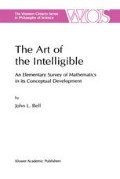Abstract
THE CONCEPT OF NUMBER HAS undergone a long evolution, and today there are several types of “number”. Let us see how this has come about.
Access this chapter
Tax calculation will be finalised at checkout
Purchases are for personal use only
Preview
Unable to display preview. Download preview PDF.
Notes
By unique here we mean unique up to congruence, that is, all such segments are congruent. 2 Here we follow the usual convention and omit the dot in multiplication.
The term “irrational” here is to be understood in the sense of “that which cannot be expressed as a ratio” as opposed to its more usual (but related) meaning “contrary to reason”.
The term “imaginary”—first used in this connection by Descartes—reflects the fact that seventeenth-century mathematicians considered square roots of negative numbers (such as) to be fictitious, the mere product of imagination. In this respect it is to be contrasted with the term “irrational”: q.v. footnote 3.
So the product of complex numbers is a “complex” of multiplication and addition.
Throughout our discussion of number theory, the term “number” or “integer” will always mean “natural number”.
Proving this theorem in one direction is easy, for if n has a factordwith 1<d >n, then d cannot divide (n − 1)! + 1, and so neither can n.
If a given event can occur in m ways and fail to occur in n ways, and if each of the m + n ways is equally likely, the probability of the event occurring is defined to be m/(m + n).
By a “sufficiently large” number of a given type we mean a number of that type exceeding some fixed number specified in advance.
The general use of the symbol π in its familiar mathematical sense was first adopted by Euler in 1737.
It was the fact that imaginary and complex numbers could not (at first) be conceived of as operations that prevented them from being regarded as “numbers” —even in this extended sense—until the end of the eighteenth century.
Strictly speaking, Frege defines this number to be what is known as the extension of the concept “equinumerous to the given concept”: see Chapter 12 for further details.
It will be seen that the concept “not identical with itself attaches to no object, so that the corresponding number is indeed zero.
Author information
Authors and Affiliations
Rights and permissions
Copyright information
© 1999 Springer Science+Business Media Dordrecht
About this chapter
Cite this chapter
Bell, J.L. (1999). The Development of the Number Concept. In: The Art of the Intelligible. The Western Ontario Series in Philosophy of Science, vol 63. Springer, Dordrecht. https://doi.org/10.1007/978-94-011-4209-0_3
Download citation
DOI: https://doi.org/10.1007/978-94-011-4209-0_3
Publisher Name: Springer, Dordrecht
Print ISBN: 978-1-4020-0007-2
Online ISBN: 978-94-011-4209-0
eBook Packages: Springer Book Archive

